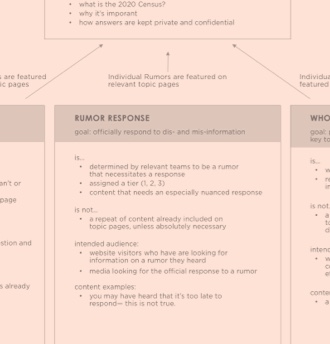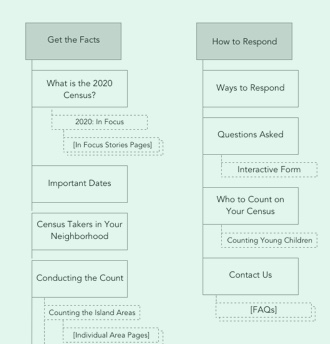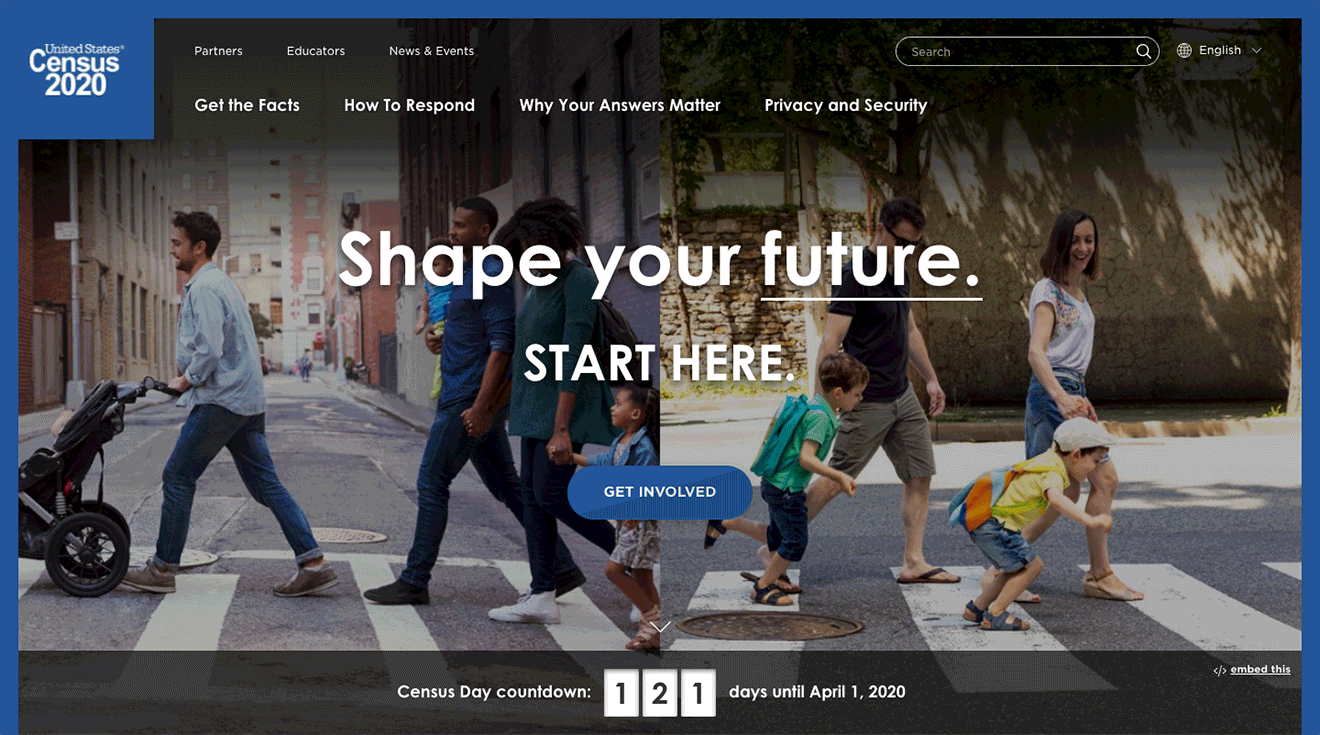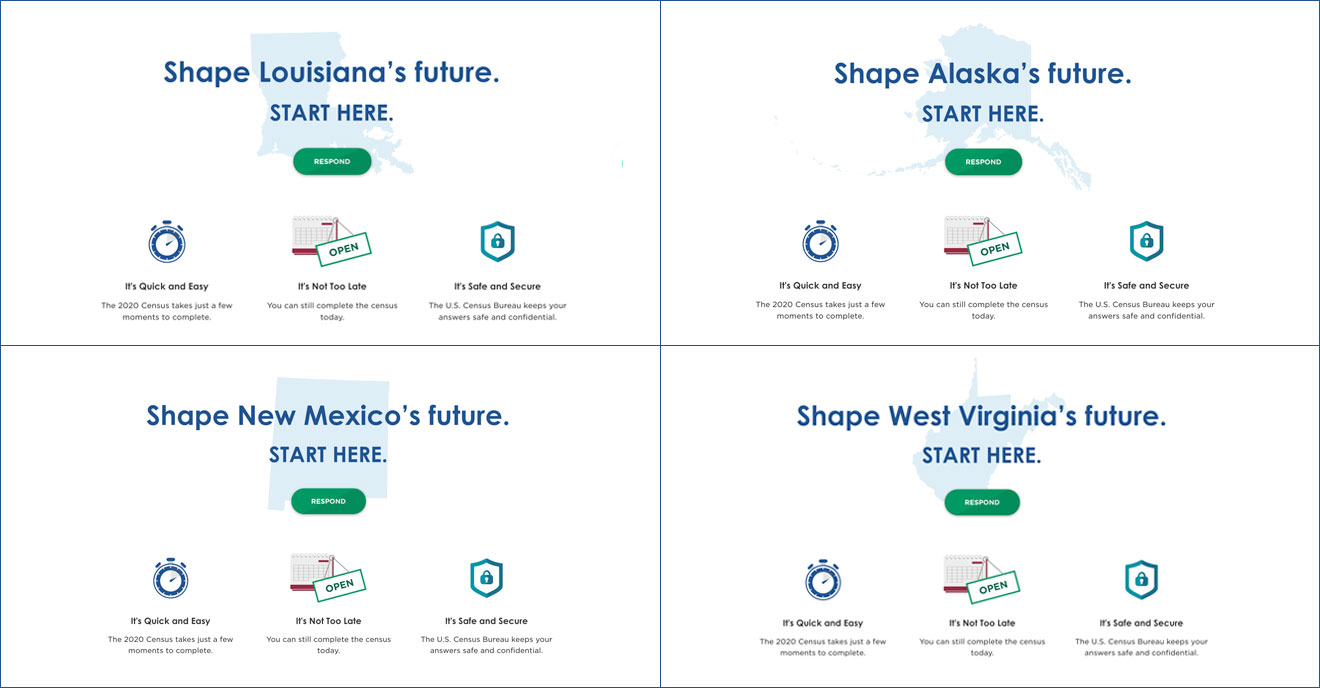

Every 10 years since 1790, the United States has undertaken the herculean task of counting everyone living in the country. In 2020, for the first time in history, everyone had the opportunity to respond to the census online. That required the U.S. Census Bureau to develop a new online approach, and a new online home for the decennial count.
As part of the comprehensive communications efforts for the 2020 Census, Reingold helped plan, create content for, and design a new website: 2020census.gov. It was a unique challenge: The site needed to provide key information to everyone in the country, while always prioritizing a clear, easy path for visitors to access the online response tool.
This meant producing pages in 59 languages. It meant finding effective ways to communicate valuable information, and provide updates during a pandemic. It meant continually testing and optimizing the experience.
The first census in U.S. history to give everyone the chance to respond online proved to be a success, despite the challenges of 2020. The census counted 99.98% of all households in the United States and its territories. And of the 67% who responded to the census on their own, without the help of census takers, more than half did so online — exceeding the Census Bureau’s goal for online responses.
The site directed nearly 50 million visitors to the online census form, helping the Census Bureau exceed its goal for online responses.
The site played a critical role in that success, sending nearly 50 million visitors on to the response tool, providing key updates throughout the COVID-19 pandemic, and increasing awareness of both how to respond and why responding was important. By Nov. 23, 2020, the site had received more than 105 million visits. And it was an instrumental part in winning the 2020 Gold Effie for the Shape Your Future campaign, one of the marketing industry’s highest accolades.
The Census Bureau needed a site that could evolve in step with their multi-year, multi-channel communication strategy. It would need to change significantly during different phases of the campaign: from engaging partners to raising public awareness, to driving response, and finally, reporting results. Through story mapping workshops, our team created user stories to guide the content and features that would be needed throughout the lifespan of the website. From there, we developed task flows, a content model, and information architecture.





UX Strategy
At left is a photo from our story mapping workshop. At right, in clockwise order, are excerpts from the resulting user stories, task flows, content model and sitemap.
Developing and updating content for the website required tight coordination among Census Bureau stakeholders, writers, editors, designers and translators. We worked with the Census Bureau to develop a detailed content workflow that went from initial outline to draft copy and layout, through stakeholder reviews, transcreation, editorial review, stakeholder approval and finally, publishing.
The official website of the 2020 Census needed to be an effective resource for an unprecedented 160 million households. The primary goal was to drive visitors to the online response tool. But the site also needed to:
To ensure that the site could inform as many people as possible, we helped develop pages in 58 non-English languages. These pages detailed key information about the census, including how to respond, why the census was important for communities across the country, and how respondents’ privacy was protected.
Rendering content in Arabic, French, Korean, Russian, and 54 other languages required more than translation support. It required coordination between web designers, developers, and the DevOps team.

For example, we needed to identify a font family that both aligned with 2020 Census branding and supported the unique characters in each language. And because some languages read right to left, we needed to ensure that that text would be oriented correctly on those users’ screens.
Throughout the 2020 Census campaign, we monitored website analytics and gathered user feedback from a variety of sources including internal and external search data, Facebook chatbot data, web feedback form submissions, and social listening data. We used these insights to fine-tune the website’s content and features, ensuring that users could easily find the information they were seeking and take desired actions.

For residents of several major U.S. cities, we personalized the homepage with an image of their city’s skyline.
To further optimize the website, we conducted A/B testing to answer questions like these: What message best motivates someone to respond? What color button gets clicked on most often? Would creating localized homepages showing the skyline of the user’s city help motivate users to respond?
We investigated these questions and many more using Adobe Target and Adobe Analytics. In total, we conducted over 50 tests to optimize the 2020census.gov experience. One key change to come out of this continual optimizing was a “three pack” feature for the English- and Spanish-language homepages. The three pack — three small boxes of highlighted content — became important for conveying updates related to the end of the count.

Homepages with personalized, state-based imagery and messaging
By the end of the census, site visitors were seeing an outline of their state with a personalized heading, such as “Make Virginia Count” or “Make Missouri Count.” Testing showed that these personalized homepages, which used Adobe’s Auto-Target personalization algorithm to curate experiences based on the user, helped motivate visitors to respond.
Want to learn more? Check out this visual retrospective that we created with the Census Bureau, looking back at everything that went into making the 2020 census a success.